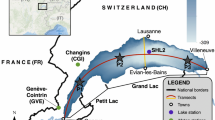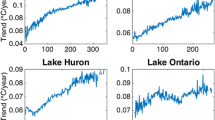Abstract
A coupled single-column atmosphere-lake model, along with the Stein–Alpert factor separation methodology, is used to explore some of the non-linear interactions in the vertical dimension between the lower atmosphere and the deep-Lake Geneva, Switzerland, during three selected periods in 1990. The first from the end of April to the end of May when Lake Geneva was building its stratification, the second from mid-August to mid-September during stable stratification, and the third from the end of November to the end of December during destratification. It is recognized that the large thermal inertia of Lake Geneva reduces the surface annual and diurnal temperature variations for neighbouring regions. However, the question of how the open water and the overlying atmosphere interact and which of these “factors” has the most influence needs much attention. The sole presence of the lake is shown to be a major feature with regard to the surface energy budget components whose contributions counteract those of the lower atmosphere, thus supporting the fact that Lake Geneva acts as a damping factor to the regional climate system. It is also shown that not only did the presence of the lake and the overlying atmosphere independently modulate the surface energy budget, but also the synergistic nonlinear interaction among them, either positive or negative, was often found non-negligible. Moreover, some processes may turn out to be important on short time scales while being negligible on the long term.




Similar content being viewed by others
References
Alpert P, Sholokhman T (eds) (2011) Factor separation in the atmosphere. Applications and future prospects. Cambridge University Press, Cambridge. doi:10.1017/CBO9780511921414
Anyah RO, Semazzi FHM (2007) Variability of East African rainfall based on multiyear RegCM3 simulations. Int J Climatol 27:357–371. doi:10.1002/joc.1401
Balsamo G, Salgado R, Dutra E, Boussetta S, Stockdale T, Potes M (2012) On the contribution of lakes in predicting near-surface temperature in a global weather forecasting model. Tellus A 64:15829. doi:10.3402/tellusa.v64i0.15829
Bode H (1945) Network analysis and feedback amplifier design. Van Nostrand, New York, p 551
Bonan GB (1995) Sensitivity of a GCM simulation to inclusion of inland water surfaces. J Clim 8:2691–2704
Burchard H, Baumert H (1995) On the performance of a mixed layer model based on the k–ε turbulence closure. J Geophys Res 100:8523–8540. doi:10.1029/94JC03229
Butcher JB, Nover D, Johnson TE, Clark CM (2015) Sensitivity of lake thermal and mixing dynamics to climate change. Clim Change 129:295–305. doi:10.1007/s10584-015-1326-1
Caya D, Laprise R (1999) A semi-implicit semi Lagrangian regional climate model: the Canadian RCM. Mon Weather Rev 127:341–362
George DG (ed) (2010) The impact of climate change on European lakes. Aquatic Ecology Series, Springer, Dordrecht, p 507
Goyette S, Perroud M (2012) Interfacing a one-dimensional lake model with a single-column atmospheric model: application to the deep Lake Geneva, Switzerland. Water Resour Res 48:W04507. doi:10.1029/2011WR011223
Goyette S, McFarlane NA, Flato GM (2000) Application of the Canadian Regional Climate Model to the Laurentian Great Lakes region: implementation of a lake model. Atmos.-Ocean 38:481–503. doi:10.1080/07055900.2000.9649657
Goyette S, Collet C, Beniston M (2001) Specification of surface characteristics for use in high resolution regional climate model: on the role of glaciers in the swiss alps. In: Beniston M, Verstraete MM (eds) Remote sensing and climate modeling: synergies and limitations. Kluwer Academic Publishers, Berlin, pp 247–271
Henderson-Sellers A (1993) A factorial assessment of the sensitivity of the BATS land-surface parameterization scheme. J Clim 6:227–247
Hostetler SW, Giorgi F (1992) Use of a regional atmospheric model to simulate lake-atmosphere feedbacks associated with Pleistocene Lakes Lahontan and Bonneville. Clim Dyn 7:39–44
Hu Z, Islam S (1996) A method to evaluate the importance of interactions between land surface and atmosphere. Water Resour Res 32:2497–2505. doi:10.1029/96WR01395
IPCC (2014) Climate change 2014: impacts, adaptation, and vulnerability. Part A: global and sectoral aspects. Contribution of working group II to the fifth assessment report of the intergovernmental panel on climate change. In: Field CB, Barros VR, Dokken DJ, Mach KJ, Mastrandrea MD, Bilir TE, Chatterjee M, Ebi KL, Estrada YO, Genova RC, Girma B, Kissel ES, Levy AN, MacCracken S, Mastrandrea PR, White LL (eds). Cambridge University Press, Cambridge, p 1132
Kalnay EN, Kanamitsu N et al (1996) The NCEP/NCAR 40-year reanalysis project. Bull Am Meteorol Soc 77:437–471
Krichak SO, Alpert P (2002) A fractional approach to the factor separation method. J Atmos Sci 59:2243–2252. doi:10.1175/1520-0469(2002)059<2243:AFATTF>2.0.CO;2
Lahellec A, Dufresne JL (2013) A formal analysis of the feedback concept in climate models. Part I: exclusive and inclusive feedback analyses. J Atmos Sci 70:3940–3958. doi:10.1175/JAS-D-12-0218.1
Livingstone DM (2003) Impact of secular climate change on the thermal structure of a large temperate central European lake. Clim Change 57:205–225. doi:10.1023/A:1022119503144
Lu J, Cai M (2009) A new framework for isolating individual feedback processes in coupled general circulation climate models: I. Formulation. Clim Dyn 32:873–885. doi:10.1007/s00382-008-0425-3
Mallard MS, Nolte CG, Spero TL, Bullock OR, Alapaty K, Herwehe JA, Gula J, Bowden JH (2014) Technical challenges and solutions in representing lakes when using WRF in downscaling applications. Geosci Model Dev Discuss 7:7121–7150. doi:10.5194/gmd-8-1085-2015
Martynov A, Sushama L, Laprise R, Winger K, Dugas B (2012) Interactive lakes in the Canadian Regional Climate Model, version 5: the role of lakes in the regional climate of North America. Tellus A 64:16226. doi:10.3402/tellusa.v64i0.16226
McFarlane NA, Boer GJ, Blanchet J-P, Lazare M (1992) The Canadian climate centre second generation general circulation model and its equilibrium climate. J Clim 5:1013–1044
Mironov D, Rontu L, Kourzeneva E, Terzhevik A (2010) Towards improved representation of lakes in numerical weather prediction and climate models. Boreal Environ Res 15:97–99
Mitchell CS, Potter GL, Ellsaesser HW, Walton JJ (1981) Case study of feedbacks and synergisms in a doubled CO2 experiment. J Atmos Sci 38:1906–1910
Mölders N (2000) Application of the principle of superposition to detect nonlinearity in the short-term atmospheric response to concurrent land-use changes associated with future landscapes. Meteorol Atmos Phys 72:47–68
Peeters F, Livingstone DM, Goudsmit G, Kipfer R, Foster R (2002) Modeling 50 years of historical temperature profiles in a large central European lake. Limnol Oceanogr 47:186–197
Perroud M, Goyette S (2012) Interfacing a one-dimensional lake model with a single-column atmospheric model II. Thermal response of the deep Swiss Lake Geneva under a 2× CO2 global climate change. Water Resour Res 48:W06522. doi:10.1029/2011WR011222
Perroud M, Goyette S, Martynov A, Beniston M, Anneville O (2009) Simulation of multiannual thermal profiles in deep Lake Geneva: a comparison of one-dimensional lake models. Limnol Oceanogr 54:1574–1594
Pitman AJ, Henderson-Sellers A, Yang ZL (1990) Sensitivity of regional climates to localized precipitation in global models. Nature 346:734–737
Rodi W (1984) Turbulence models and their application in hydrodynamics—a state of the art review, 2nd edn. International Association for Hydraulic Research, Delft
Samuelsson P, Kourzeneva E, Mironov D (2010) The impact of lakes on the European climate as simulated by a regional climate model. Boreal Environ Res 15:113–129
Stauffer DR, Seaman NL (1990) Use of four-dimensional data assimilation in a limited-area mesoscale model. Part I: experiments with synoptic-scale data. Mon Weather Rev 118:1250–1277
Stefan HG, Fang X, Hondzo M (1998) Simulated climate change effects on year-round water temperatures in temperate zone lakes. Clim Change 40:547–576
Stein U, Alpert P (1993) Factor separation in numerical simulations. J Atmos Sci 50:2107–2115
Stepanenko VM, Goyette S, Martynov A, Perroud M, Fang X, Mironov D (2010) First steps of a Lake Model intercomparison project: LakeMIP. Boreal Environ Res 15:191–202
Stepanenko VM, Martynov A, Joehnk KD, Subin SM, Perroud M, Fang X, Beyrich F, Mironov D, Goyette S (2013) A one-dimensional model intercomparison study of thermal regime of a shallow turbid midlatitude lake. Geosci Model Dev 6:1337–1352. doi:10.5194/gmd-6-1337-2013
Stepanenko V, Jöhnk K, Machulskaya E, Perroud M, Subin Z, Nordbo A, Mammarella I, Mironov D (2014) Simulation of surface energy fluxes and stratification of a small boreal lake by a set of one-dimensional models. Tellus A. doi:10.3402/tellusa.v66.21389
Subin Z, Riley WJ, Mironov D (2012) An improved lake model for climate simulations: model structure, evaluation, and sensitivity analyses in CESM1. J Adv Model Earth Syst 4:M02001. doi:10.1029/2011MS000072
Thiery W, Stepanenko VM, Fang X, Jöhnk KD, Li Z, Martynov A, Perroud M, Subin ZM, Darchambeau F, Mironov D, van Lipzig NPM (2014a) LakeMIP Kivu: evaluating the representation of a large, deep tropical lake by a set of one-dimensional lake models. Tellus A 66:21390. doi:10.3402/tellusa.v66.21390
Thiery W, Martynov A, Darchambeau F, Descy J-P, Plisnier P-D, Sushama L, van Lipzig NPM (2014b) Understanding the performance of the FLake model over two African Great Lakes. Geosci Model Dev 7:317–337
Thiery W, Davin EL, Panitz H-J, Demuzere M, Lhermite S, vanLipzing N (2015) The impact of the African Great Lakes on the regional climate. J Clim 28:4061–4085. doi:10.1175/JCLI-D-14-00565.1
Acknowledgments
I would like to thank the Ouranos consortium in Montreal for providing an access to the CRCM source code. I thank the Swiss EAWAG for providing an access to lake model SIMSTRAT. I am also grateful to the reviewers for their comments to help improving the quality of this paper as well as to Martin Lacayo for valuable language editing and proof reading.
Author information
Authors and Affiliations
Corresponding author
Rights and permissions
About this article
Cite this article
Goyette, S. Numerical investigation with a coupled single-column lake-atmosphere model: using the Alpert–Stein factor separation methodology to assess the sensitivity of surface interactions. Clim Dyn 48, 2359–2373 (2017). https://doi.org/10.1007/s00382-016-3209-1
Received:
Accepted:
Published:
Issue Date:
DOI: https://doi.org/10.1007/s00382-016-3209-1




